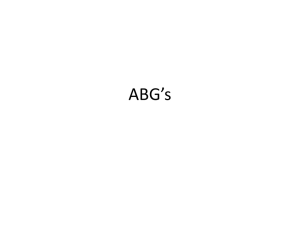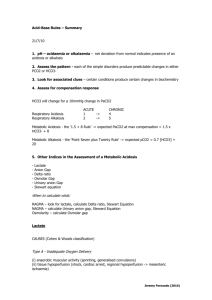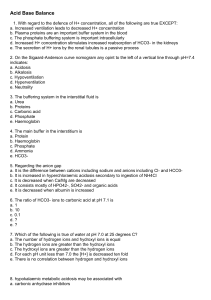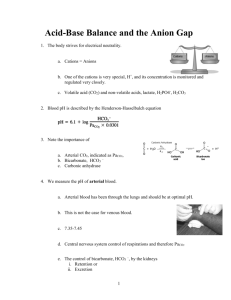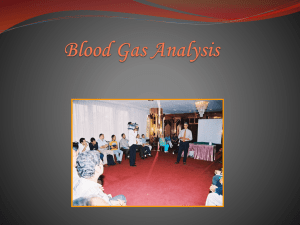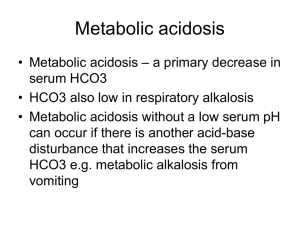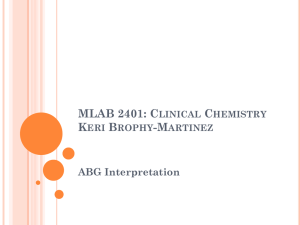Acid Base - acbsww.org.uk
advertisement
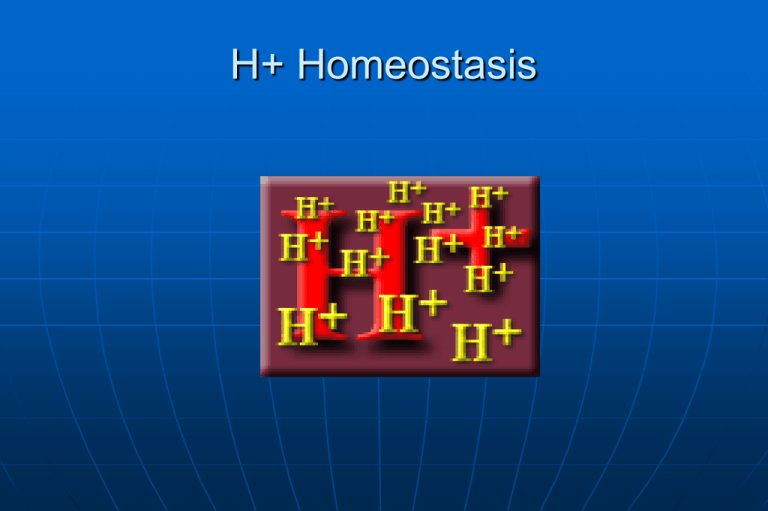
H+ Homeostasis H+ homeostasis Why is it so important? • Organ function • Cellular function • Enzyme and protein function Acid production Respiratory acid • CO2 as carbonic acid Metabolic acids • • • • Organic acids Lactate Pyruvate Keto-acids Lungs Kidneys Traditional pH control Respiratory control of CO2 • Ventilation rate and depth • Rapid and very sensitive Kidney control of H+ and HCO3- (maybe..) • NH4+ • Phosphates • Organic acids • Slower and less efficient Henderson equation: [ H+ ] x [ HCO3- ] = k x [ CO2 ] x [ H2O ] The trouble with Henderson.. [H+] ≈ CO2/HCO3But if CO2 rises so will HCO3Danish polio epidemic So how can you distinguish between respiratory and metabolic problems? • Standard bicarbonate (1957) • BE or SBE (1958) • Boston rules History terminology bicarbonate at normal temp. and PCO2 An alternative explanation.. All H+ comes from the dissociation of water Anything that controls or effects water dissociation controls pH The Six Simultaneous Equations used by Stewart 1. Water Dissociation Equilibrium [H+] x [OH-] = K’w 2. Electrical Neutrality Equation [SID] + [H+] = [HCO3-] + [A-] + [CO3-2] + [OH-] 3. Weak Acid Dissociation Equilibrium [H+] x [A-] = KA x [HA] 4. Conservation of Mass for "A“ [ATot] = [HA] + [A-] 5. Bicarbonate Ion Formation Equilibrium [H+] x [HCO3] = KC x pCO2 6. Carbonate Ion Formation Equilibrium [H+] x [CO3-2] = K3 x [HCO3-] 3 factors independently control water dissociation or [H+] 1. 2. 3. CO2 (pCO2) Strong ion difference (SID) Total weak acid concentration (AH) Neither pH nor HCO3- can be regulated directly. Their concentrations are determined by other independent variables. The ratio of CO2/HCO3- describes pH but does not determine it…Henderson is only 1/6th of the story! Strong Ion Difference (SID) SIDa is always positive Should equal sum of HCO3 and A- (SIDe) SIG = unmeasured anions and should be zero Unmeasured anions are • Ketoacids,organic acids • Exogenous acids • Gelatins, citrate Where does Anion gap fit in? Anion gap = (Na + K) – (Cl + HCO3) Clever AG = AG – [0.25 x albumin] – lactate Easier than SIG and well correlated Note that a low albumin will augment an anion gap If SID falls, pH falls. SIG is a clever Anion gap (corrects for albumin, phosphate, lactate, Mg and Ca) Total concentration of weak acids (Atot) 3. Weak Acid Dissociation Equilibrium [H+] x [A-] = KA x [HA] 4. Conservation of Mass for "A“ [ATot] = [HA] + [A-] • Low albumin is alkalinizing… • Less HA means less H+ • Low albumin may mask an acidosis Stewart’s bottom line(s).. It is not the direct control of HCO3- and H+ that determines pH. It is the direct effect of CO2, SID and ATot that regulates the dissociation of water. • CO2 is controlled by ventilation (lungs) • SID is controlled by strong ion handling esp. Chloride/sodium (kidneys) • ATot is chiefly determined by albumin and phosphate concentration (kidneys and liver) It is the degree of water dissociation that determines pH Back to the traditional.. …..With some unification Blood gas analysis 1. Assess Oxygenation • • 2. What is the pH • • 3. pH>7.45 (H+ < 35) alkalosis pH<7.35 (H+ > 45) acidosis Is it a ventilation problem? • • Is the patient hypoxic Is there a significant A-a Gradient PaCO2: PaCO2: >6.0 kPa - respiratory acidosis <4.7kPa - respiratory alkalosis Both methods agree 4. Is there a metabolic problem? What is the HCO3- or SBE? (..or SID) SBE -2=metabolic acidosis SBE +2=metabolic acidosis 5. Is it both? 6. Investigate Metabolic acidosis (hunt the kipper) Gem 3000 Measured variables Ph pCO2 P02 Na K Ca total Glucose Lactate Hct Derived variables Ca ionised HCO3 BE/SBE O2 %Sats Hb Respiratory Acidosis Any cause of hypoventilation (high CO2) • CNS depression • Neuromuscular disease • Acute or chronic lung disease • Cardiac arrest • Ventilator malfunction Respiratory Alkalosis Any cause of hyperventilation (low CO2) • Hypoxia • Acute lung conditions • Anxiety • Fever • Pregnancy • Hepatic failure • Some central CNS lesions Metabolic Acidosis (low SID) Increased anion gap or SIG (unmeasured anions) Endogenous acids • Renal failure..organic acids • Ketoacidosis/starvation • Lactic acidosis Exogenous acids • Salicylate/Tricyclic/methanol overdose • Citrate • gelatins Metabolic Acidosis Decreased or normal anion gap or SIG • • • • • Diarrhoea (loss Na>Cl) Carbonic anhydrase inhibitors Ureteral diversion Chloride administration Renal tubular acidosis ?Cl retention Metabolic Alkalosis (increased SID or low albumin) Loss of acid or gaining alkali or loss Chloride gaining Na • Vomiting • Diarrhoea • Diuretics (and hypokalaemia generally) • Cushings/steroids/mineralocorticoids • Ingestion/administration of alkali or is it Na? Reminder of normal values pH = 7.35 – 7.45 [H+ = 35 -45nmol/l] pO2 = 10 -13 kPa on air pCO2 = 4.6 – 6.0 kPa HCO3 = 25 – 35 mmols/l Base excess ± 2.0 Lactate < 1.0 mmols/l Chloride = 100 Albumin 35 Anion gap 10-12 but less if albumin low SIG = 0 Bed 1 Middle aged man admitted with cough sputum and haemoptysis. Life-long smoker pO2 4 on air H+ 65 pH 7.19 PaCO2 9.7 HCO3 28 Bed 2 Middle aged man admitted with cough sputum and haemoptysis. Life-long smoker pO2 6 on air SpO2 92% H+ 46 pH 7.32 PaCO2 10.0 HCO3 39 Bed 9 50 yr-old man admitted with exacerbation of long-standing bronchial asthma. Respiratory rate of 18 pO2 5.1 on 60% oxygen H+ 41 pH 7.39 PaCO2 5.8 HCO3 26 or corrected Anion Gap (AGc) Bed 3 Young female admitted with overdose of unknown tablets and smelling of alcohol pO2 12 kPa on air H+ 58 pH 7.24 PaCO2 2.5 HCO3 8 I need to know… SBE Lactate Corrected Anion gap or Strong ion gap (chloride) SBE -12 Lactate 4 Corrected Anion gap high (>12) Bed 4 Elderly male admitted from nursing home with one week history of fever and vomiting pO2 12 kPa on 4L/min by mask H+ 32 pH 7.49 PaCO2 6.3 HCO3 35 SBE +8 Lactate 3 Bed 5 Middle aged man post cardiac arrest. Breathing spontaneously on endotracheal tube pO2 35 on 15l via resus bag (with reservoir) H+ 126 pH 6.9 PaCO2 8.9 HCO3 13 SBE -20 Lactate 12 Cl 111 Bed 6 Elderly lady with congestive cardiac failure pO2 9 on 40% oxygen H+ 23 pH 7.64 PaCO2 3.5 HCO3 29 SBE +2 Bed 7 Young diabetic male admitted with chest infection, vomiting and drowsiness pO2 12 on air H+ 49 pH 7.31 PaCO2 1.6 HCO3 6.0 SBE -18 Lactate 6 Cl 111 Bed 8 54 yr-old lady post MI. Acutely unwell, cold, clammy, hypotensive and oliguric pO2 10 on 60% oxygen H+ 102 pH 6.99 PaCO2 7.8 HCO3 14 SBE -17 Lactate 6 Cl 101 Bed 10 40 year old woman with pancreatitis and sepsis has been resuscitated aggressively with IV fluids on the ward for 24 hours pH 7.30 Na 138 pO2 8.21 FiO2 0.7 K 3.5 pCO2 3.5 Ca2+ 1.15 HCO3- 14.6 Cl- 116 Anion gap =10.9 albumin 15 Apparently “normal anion gap” acidosis, points to chloride…but Albumin is very low SIG is high…because SIDe (A- + HCO3-) is low Lactate was 4 Still underesuscitated.


